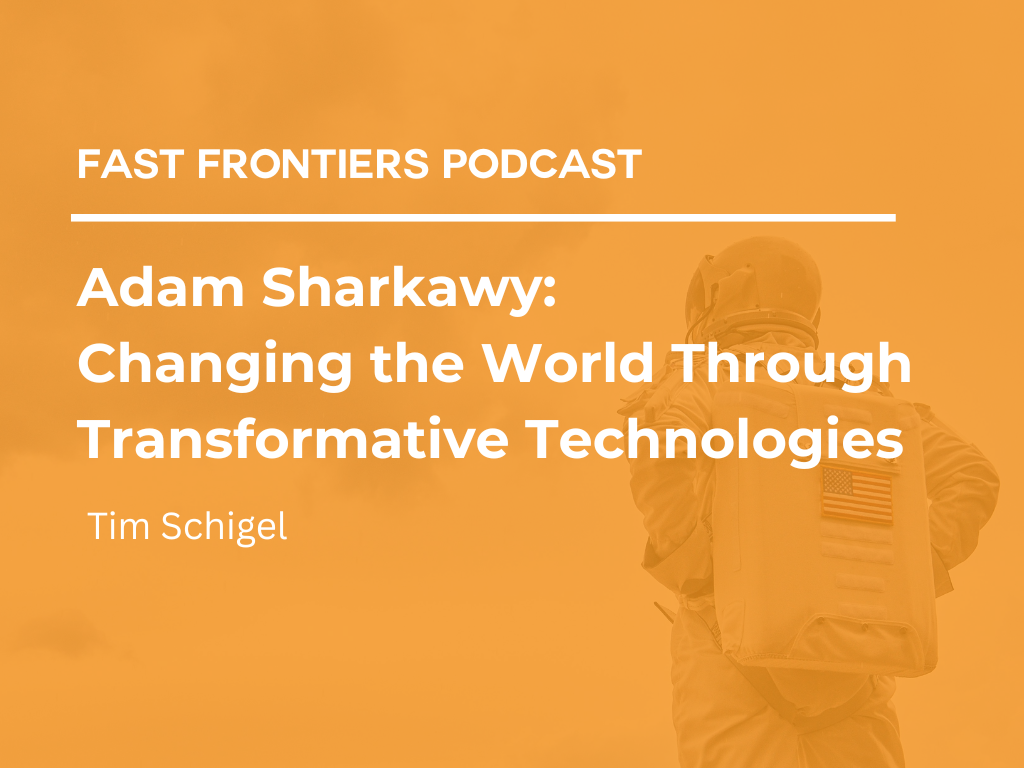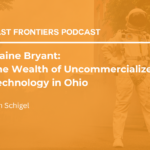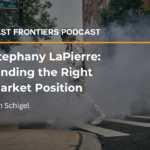Recently, Fast Frontiers welcomed Adam Sharkawy to share his insights with us. As Co-founder and Managing Partner of Material Impact Venture Fund, Adam is a perfect fit as a guest working on the leading edge of an innovative frontier: “hard tech,” as some would call it.
Adam has a fascinating personal story that had a significant impact on and informed much of how he operates in the world today, particularly how he approaches investing. Born in Cairo, Egypt, Adam arrived in the U.S. (Delaware to be exact) with his parents at the age of three. Growing up, he spent a lot of time on the University of Delaware campus where both of his parents worked. After school, Adam described he’d “just walk over to the student center, and instead of babysitting, my mom would just drop me off with a bunch of hippie students.”
Listening to him talk, you can see this season of life brings back excellent memories. But soon, Adam became curious about his roots. So, he headed back to Egypt for about three and a half years, during which time he earned an engineering degree. Adam recalled his “seminal set of experiences” in Egypt: “I saw so many things there that just influenced me in a way to really appreciate how innovative people were when they really needed to be—when they didn’t have these macro functions to call.”
He explained, “I was doing engineering in an environment where innovation was almost baked into individualized efforts on a daily basis, and that I think really influenced me.”
Adam Sharkawy’s “Algorithm”
Returning to the U.S. and the San Francisco Bay Area in the mid-eighties, Adam arrived amid Silicon Valley’s legendary chip boom. This mecca of microelectronics attracted Adam due to his hope to marry his love for both engineering and the life sciences.
And he did. You could safely say it was a blissful union. Adam described the first half of his career as his serial entrepreneur phase, where he experienced great success in having every startup that he was involved with get acquired.
Adam developed a pattern, or an “algorithm,” as he called it, where he would return to school after every exit.
Beginning with an academic interlude to study chaos theory—which attracted his interest because of its intersection between non-linear mathematics, fractals, and innovation—Adam proceeded to go on an educational and entrepreneurial journey.
Of chaos theory, Adam explained, “It was really eye-opening for me because what I was doing more specifically was trying to figure out how to think non-linearly.” He added that it became “a means to try to energize the innovation process through non-linear thinking.”
More successful startups, and schools, followed, including a Ph.D. from Duke in biomedical engineering and biomaterials.
Increasing Enterprise Value Through Innovation from Both Sides
After this, Adam shared how he “decided to jump to the other side of the fence and try to get an understanding of almost the exact opposite of what I was doing, which was—instead of starting up small things and trying to grow them to a certain point and then selling them off—to run a large scale business and try to acquire things and use those to bolt on and grow them at scale.” This led him to what he jokingly described as “the dark world of corporate leadership” and membership of leadership teams of really large fortune 500 companies in the healthcare field. These include big guns like Guidant, Abbott, Smith and Nephew, and The Medicines Company—just to toss out a few.
“Through that course, I did a lot of acquisitions,” Adam shared, an experience he is grateful for as it was really when, according to him, he started to develop his own thesis around how one can increase enterprise value through innovation from both sides of the fence.
Fast forward to 2015, and the itch of entrepreneurship returned in full force. “I really wanted to go back to my entrepreneurial roots,” he said.
Changing the World Through Transformative Technologies
Enter Material Impact. Adam shared his mentality when approaching the creation of his own company: “Instead of doing so across one company, I thought it would be great to leverage experiences across many companies, and to do so in a way where we’d be able to help out younger, brighter entrepreneurs than us … Really take the baton and change the world through their transformative technologies.”
This was an exciting vision shared by Adam’s good friend, Carmichael Roberts, who he met from his Ph.D. days at Duke. “He and I were very similar in our backgrounds. When I went [into] the world of corporate leadership, he went into the venture world, and I thought we’re common to our core, but we have this complimentary as well, and so it’ll be great to join forces and start our own fund.” Out of this perfect pairing came Material Impact.
According to its website, Material Impact “transforms materials into companies that make an impact.” Far and above being mere technology scouts and company creators, Material Impact describes its team as being “builders”—builders who “seek out novel materials and grow them into great products and enduring companies that solve real-world problems.”
The Three Tenets of Material Impact
Adam explained the three basic tenets of Material Impact, the first being that it’s “a deep tech fund that firmly believes that you can trace back almost every disruption in any market or industry segment to an underlying material science enabler.” He added, “We think that material science advancements unlock new engineering solutions and new engineer paradigms, so the laws of engineering continuously change based on the axioms of what material science allows. Even Newtonian mechanics changed based on new material properties.”
The second tenant is that the company focuses on substantial, unmet needs of humankind— needs that Adam calls “Maslovian needs” (referring to those needs found at the lowest base of Maslow’s triangle, such as issues surrounding water scarcity and food supply chain, underrepresented segments of healthcare, certain aspects of transportation, etc.).
Adam shared how the third tenant is really the reason Material Impact was started in the first place: “To get involved very, very intimately with our founders, where we spend a lot of time trying to leverage our own experiences to helping them build their companies.”
Sounds remarkable, right? According to Adam, it is. One of the most notable aspects of many is pulling tech and Intellectual Property out of corporate innovations and startups—an endeavor that is hard to do. However, Adam can attest that when done well, it can be hugely disruptive (in a good way).
Want to hear more insights from Adam? Listen to the entire podcast here



